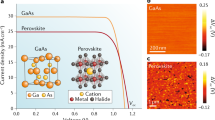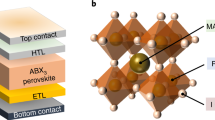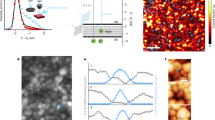Abstract
Halide perovskites perform remarkably in optoelectronic devices. However, this exceptional performance is striking given that perovskites exhibit deep charge-carrier traps and spatial compositional and structural heterogeneity, all of which should be detrimental to performance. Here, we resolve this long-standing paradox by providing a global visualization of the nanoscale chemical, structural and optoelectronic landscape in halide perovskite devices, made possible through the development of a new suite of correlative, multimodal microscopy measurements combining quantitative optical spectroscopic techniques and synchrotron nanoprobe measurements. We show that compositional disorder dominates the optoelectronic response over a weaker influence of nanoscale strain variations even of large magnitude. Nanoscale compositional gradients drive carrier funnelling onto local regions associated with low electronic disorder, drawing carrier recombination away from trap clusters associated with electronic disorder and leading to high local photoluminescence quantum efficiency. These measurements reveal a global picture of the competitive nanoscale landscape, which endows enhanced defect tolerance in devices through spatial chemical disorder that outcompetes both electronic and structural disorder.
This is a preview of subscription content, access via your institution
Access options
Access Nature and 54 other Nature Portfolio journals
Get Nature+, our best-value online-access subscription
$29.99 / 30 days
cancel any time
Subscribe to this journal
Receive 12 print issues and online access
$259.00 per year
only $21.58 per issue
Buy this article
- Purchase on Springer Link
- Instant access to full article PDF
Prices may be subject to local taxes which are calculated during checkout




Similar content being viewed by others
Data availability
The data and code that support the findings of this study are available in the University of Cambridge Apollo repository at https://doi.org/10.17863/CAM.76854.
References
Kim, J. Y., Lee, J.-W., Jung, H. S., Shin, H. & Park, N.-G. High-efficiency perovskite solar cells. Chem. Rev. 120, 7867–7918 (2020).
Quan, L. N. et al. Perovskites for next-generation optical sources. Chem. Rev. 119, 7444–7477 (2019).
Saliba, M. et al. Cesium-containing triple cation perovskite solar cells: improved stability, reproducibility and high efficiency. Energy Environ. Sci. 9, 1989–1997 (2016).
Saliba, M. et al. Incorporation of rubidium cations into perovskite solar cells improves photovoltaic performance. Science 354, 206–209 (2016).
Abdi-Jalebi, M. et al. Maximising and stabilising luminescence in metal halide perovskite device structures. Nature 555, 497–501 (2018).
Tong, J. et al. Carrier lifetimes of >1 μs in Sn-Pb perovskites enable efficient all-perovskite tandem solar cells. Science 364, 475 (2019).
Köhnen, E. et al. Highly efficient monolithic perovskite silicon tandem solar cells: analyzing the influence of current mismatch on device performance. Sustain. Energy Fuels 3, 1995–2005 (2019).
Xu, J. et al. Triple-halide wide–band gap perovskites with suppressed phase segregation for efficient tandems. Science 367, 1097 (2020).
Al-Ashouri, A. et al. Monolithic perovskite/silicon tandem solar cell with >29% efficiency by enhanced hole extraction. Science 370, 1300 (2020).
Tennyson, E. M., Doherty, T. A. S. & Stranks, S. D. Heterogeneity at multiple length scales in halide perovskite semiconductors. Nat. Rev. Mater. https://doi.org/10.1038/s41578-019-0125-0 (2019).
de Quilettes, D. W. et al. Impact of microstructure on local carrier lifetime in perovskite solar cells. Science 348, 683 (2015).
deQuilettes, D. W. et al. Tracking photoexcited carriers in hybrid perovskite semiconductors: trap-dominated spatial heterogeneity and diffusion. ACS Nano 11, 11488–11496 (2017).
El-Hajje, G. et al. Quantification of spatial inhomogeneity in perovskite solar cells by hyperspectral luminescence imaging. Energy Environ. Sci. 9, 2286–2294 (2016).
Stolterfoht, M. et al. Visualization and suppression of interfacial recombination for high-efficiency large-area pin perovskite solar cells. Nat. Energy 3, 847–854 (2018).
Doherty, T. A. S. et al. Performance-limiting nanoscale trap clusters at grain junctions in halide perovskites. Nature 580, 360–366 (2020).
Grancini, G. et al. One-year stable perovskite solar cells by 2D/3D interface engineering. Nat. Commun. 8, 15684 (2017).
Ni, Z. et al. Resolving spatial and energetic distributions of trap states in metal halide perovskite solar cells. Science 367, 1352–1358 (2020).
Jariwala, S. et al. Local crystal misorientation influences non-radiative recombination in halide perovskites. Joule 3, 3048–3060 (2019).
Jones, T. W. et al. Lattice strain causes non-radiative losses in halide perovskites. Energy Environ. Sci. 12, 596–606 (2019).
Kim, G. et al. Impact of strain relaxation on performance of α-formamidinium lead iodide perovskite solar cells. Science 370, 108 (2020).
Correa-Baena, J.-P. et al. Homogenized halides and alkali cation segregation in alloyed organic-inorganic perovskites. Science 363, 627 (2019).
Hoke, E. T. et al. Reversible photo-induced trap formation in mixed-halide hybrid perovskites for photovoltaics. Chem. Sci. 6, 613–617 (2015).
Slotcavage, D. J., Karunadasa, H. I. & McGehee, M. D. Light-induced phase segregation in halide-perovskite absorbers. ACS Energy Lett. 1, 1199–1205 (2016).
Brennan, M. C., Draguta, S., Kamat, P. V. & Kuno, M. Light-induced anion phase segregation in mixed halide perovskites. ACS Energy Lett. 3, 204–213 (2018).
Leijtens, T., Bush, K. A., Prasanna, R. & McGehee, M. D. Opportunities and challenges for tandem solar cells using metal halide perovskite semiconductors. Nat. Energy 3, 828–838 (2018).
Mahesh, S. et al. Revealing the origin of voltage loss in mixed-halide perovskite solar cells. Energy Environ. Sci. 13, 258–267 (2020).
Feldmann, S. et al. Photodoping through local charge carrier accumulation in alloyed hybrid perovskites for highly efficient luminescence. Nat. Photonics 14, 123–128 (2020).
Miller, O. D., Yablonovitch, E. & Kurtz, S. R. Strong internal and external luminescence as solar cells approach the Shockley–Queisser limit. IEEE J. Photovolt. 2, 303–311 (2012).
Galisteo-López, J. F., Anaya, M., Calvo, M. E. & Míguez, H. Environmental effects on the photophysics of organic–inorganic halide perovskites. J. Phys. Chem. Lett. 6, 2200–2205 (2015).
Andaji-Garmaroudi, Z., Anaya, M., Pearson, A. J. & Stranks, S. D. Photobrightening in lead halide perovskites: observations, mechanisms, and future potential. Adv. Energy Mat. 10, 1903109 (2020).
Katahara, J. K. & Hillhouse, H. W. Quasi-Fermi level splitting and sub-bandgap absorptivity from semiconductor photoluminescence. J. Appl. Phys. 116, 173504 (2014).
Stolterfoht, M. et al. The impact of energy alignment and interfacial recombination on the internal and external open-circuit voltage of perovskite solar cells. Energy Environ. Sci. 12, 2778–2788 (2019).
Wang, J. et al. Reducing surface recombination velocities at the electrical contacts will improve perovskite photovoltaics. ACS Energy Lett. 4, 222–227 (2019).
Mann, S. A. et al. Quantifying losses and thermodynamic limits in nanophotonic solar cells. Nat. Nanotechnol. 11, 1071–1075 (2016).
de Mello, J. C., Wittmann, H. F. & Friend, R. H. An improved experimental determination of external photoluminescence quantum efficiency. Adv. Mater. 9, 230–232 (1997).
Richter, J. M. et al. Enhancing photoluminescence yields in lead halide perovskites by photon recycling and light out-coupling. Nat. Commun. 7, 13941 (2016).
Ross, R. T. Some thermodynamics of photochemical systems. J. Chem. Phys. 46, 4590–4593 (1967).
Ledinsky, M. et al. Temperature dependence of the Urbach energy in lead iodide perovskites. J. Phys. Chem. Lett. 10, 1368–1373 (2019).
Urbach, F. The long-wavelength edge of photographic sensitivity and of the electronic absorption of solids. Phys. Rev. 92, 1324–1324 (1953).
Piccardo, M. et al. Localization landscape theory of disorder in semiconductors. II. Urbach tails of disordered quantum well layers. Phys. Rev. B. 95, 144205 (2017).
Rolston, N. et al. Engineering stress in perovskite solar cells to improve stability. Adv. Energy Mat. 8, 1802139 (2018).
Martín-Sánchez, J. et al. Strain-tuning of the optical properties of semiconductor nanomaterials by integration onto piezoelectric actuators. Semicond. Sci. Technol. 33, 013001 (2017).
Bioud, Y. A. et al. Uprooting defects to enable high-performance III–V optoelectronic devices on silicon. Nat. Commun. 10, 4322 (2019).
Hubbard, S. M. et al. Effect of strain compensation on quantum dot enhanced GaAs solar cells. Appl. Phys. Lett. 92, 123512 (2008).
Merdasa, A. et al. Eye in the process: formation of ‘triple cation‘ perovskite thin films rationalized by in-situ optical monitoring. Preprint at Research Square https://doi.org/10.21203/rs.3.rs-102041/v1 (2021).
Man, M. K. L. et al. Imaging the motion of electrons across semiconductor heterojunctions. Nat. Nanotechnol. 12, 36–40 (2017).
Deng, S., Blach, D. D., Jin, L. & Huang, L. Imaging carrier dynamics and transport in hybrid perovskites with transient absorption microscopy. Adv. Energy Mat. 10, 1903781 (2020).
Herz, L. M. Charge-carrier dynamics in organic-inorganic metal halide perovskites. Annu. Rev. Phys. Chem. 67, 65–89 (2016).
Yuan, M. et al. Perovskite energy funnels for efficient light-emitting diodes. Nat. Nanotechnol. 11, 872–877 (2016).
Li, C. et al. Conformational disorder of organic cations tunes the charge carrier mobility in two-dimensional organic-inorganic perovskites. Nat. Commun. 11, 5481 (2020).
Szostak, R. et al. Nanoscale mapping of chemical composition in organic-inorganic hybrid perovskite films. Sci. Adv. 5, eaaw6619 (2019).
Zhao, J. et al. Strained hybrid perovskite thin films and their impact on the intrinsic stability of perovskite solar cells. Sci. Adv. 3, eaao5616 (2017).
Xue, D.-J. et al. Regulating strain in perovskite thin films through charge-transport layers. Nat. Commun. 11, 1514 (2020).
Lasher, G. & Stern, F. Spontaneous and stimulated recombination radiation in semiconductors. Phys. Rev. 133, A553–A563 (1964).
Wurfel, P. The chemical potential of radiation. J. Phys. C: Solid State Phys. 15, 3967–3985 (1982).
Brüggemann, R., Schulze, P., Neumann, O., Witte, W. & Bauer, G. H. Relation between luminescence and open-circuit voltage in Cu(In,Ga)Se2 solar cells. Thin Solid Films 535, 283–286 (2013).
Sträter, H. et al. Detailed photoluminescence studies of thin film Cu2S for determination of quasi-Fermi level splitting and defect levels. J. Appl. Phys. 114, 233506 (2013).
Babbe, F., Choubrac, L. & Siebentritt, S. Quasi Fermi level splitting of Cu-rich and Cu-poor Cu(In,Ga)Se2 absorber layers. Appl. Phys. Lett. 109, 082105 (2016).
Braly, I. L., Stoddard, R. J., Rajagopal, A., Jen, A. K. Y. & Hillhouse, H. W. Photoluminescence and photoconductivity to assess maximum open-circuit voltage and carrier transport in hybrid perovskites and other photovoltaic materials. J. Phys. Chem. Lett. 9, 3779–3792 (2018).
Halperin, B. I. & Lax, M. Impurity-band tails in the high-density limit. I. Minimum counting methods. Phys. Rev. 148, 722–740 (1966).
Braly, I. L. et al. Hybrid perovskite films approaching the radiative limit with over 90% photoluminescence quantum efficiency. Nat. Photonics 12, 355–361 (2018).
Quinn, P. D. et al. The Hard X-ray Nanoprobe beamline at Diamond Light Source. J. Synchrotron Radiat. 28, 1006–1013 (2021).
Marchal, J. et al. EXCALIBUR: a small-pixel photon counting area detector for coherent X-ray diffraction—front-end design, fabrication and characterisation. J. Phys. Conf. Ser. 425, 062003 (2013).
de la Peña, F. et al. hyperspy/hyperspy: Hyperspy v.1.5.2 (Zenodo, 2019); https://doi.org/10.5281/zenodo.1221347
Kodur, M. et al. X-ray microscopy of halide perovskites: techniques, applications, and prospects. Adv. Energy Mat. 10, 1903170 (2020).
Pareja-Rivera, C., Solís-Cambero, A. L., Sánchez-Torres, M., Lima, E. & Solis-Ibarra, D. On the true composition of mixed-cation perovskite films. ACS Energy Lett. 3, 2366–2367 (2018).
Virtanen, P. et al. SciPy 1.0: fundamental algorithms for scientific computing in Python. Nat. Methods 17, 261–272 (2020).
Schnedermann, C. et al. Sub-10 fs time-resolved vibronic optical microscopy. J. Phys. Chem. Lett. 7, 4854–4859 (2016).
Acknowledgements
K.F. acknowledges a George and Lilian Schiff Studentship, Winton Studentship, the Engineering and Physical Sciences Research Council (EPSRC) studentship, Cambridge Trust Scholarship and Robert Gardiner Scholarship. M.A. acknowledges funding from the Marie Skłodowska-Curie actions (grant agreement no. 841386) under the European Union’s Horizon 2020 research and innovation programme. S.M. and K.W.P.O. acknowledge EPSRC studentships. T.A.S.D. acknowledges a National University of Ireland Travelling Studentship. Y.-H.C. thanks the Cambridge Trust and Rank Prize fund. We acknowledge the Diamond Light Source (Didcot, Oxfordshire, UK) for providing beamtime at the I14 Hard X-ray Nanoprobe facility through proposals sp19023 and sp20420. S.D.S. acknowledges the Royal Society and Tata Group (grant no. UF150033). The work has received funding from the European Research Council under the European Union’s Horizon 2020 research and innovation programme (HYPERION, grant agreement no. 756962; SOLARX, grant agreement no. 758826). Y.H.-C. thanks the Cambridge Trust for a studentship. We acknowledge the EPSRC (grant nos. EP/R023980/1, EP/M006360/1) and the Winton Programme for the Physics of Sustainability for funding. A.J.W. and K.M.D. acknowledge that this work was supported by the Femtosecond Spectroscopy Unit of the Okinawa Institute of Science and Technology Graduate University and JSPS Kakenhi grant no. JP19K05637. We acknowledge the support for this work from the Imaging Section and Engineering Support Section of the Okinawa Institute of Science and Technology Graduate University. K.F. acknowledges N-11 for fruitful discussion. K.F., M.A., S.M. and T.A.S.D. acknowledge HQS.
Author information
Authors and Affiliations
Contributions
K.F., M.A. and S.D.S conceived the project. K.F. and M.A. developed the quantitative optical microscopy and performed the measurements, which were analysed by K.F. K.F., M.A., S.M., T.A.S.D., K.W.P.O., J.E.P. and P.D.Q. performed the synchrotron nXRF and nXRD experiments that were analysed by K.F and T.A.S.D. S.M. and J.S. performed the TAM measurements and analysed the data supervised by A.R. K.F., M.A. and S.M. performed the correlative analysis of the multimodal data. Y.-H.C. fabricated the thin film and device perovskite samples and performed bulk XRD experiments. A.J.W. performed the PEEM measurements supervised by K.M.D. S.D.S. supervised and funded the work. K.F. and M.A. wrote the draft of the manuscript with the input of S.D.S. All authors contributed to the revision of the final paper.
Corresponding authors
Ethics declarations
Competing interests
S.D.S. is a cofounder of Swift Solar.
Additional information
Peer review information Nature Nanotechnology thanks Mike McGehee and Shuji Ye for their contribution to the peer review of this work.
Publisher’s note Springer Nature remains neutral with regard to jurisdictional claims in published maps and institutional affiliations.
Supplementary information
Supplementary Information
Supplementary Figs. 1–19.
Rights and permissions
About this article
Cite this article
Frohna, K., Anaya, M., Macpherson, S. et al. Nanoscale chemical heterogeneity dominates the optoelectronic response of alloyed perovskite solar cells. Nat. Nanotechnol. 17, 190–196 (2022). https://doi.org/10.1038/s41565-021-01019-7
Received:
Accepted:
Published:
Issue Date:
DOI: https://doi.org/10.1038/s41565-021-01019-7
This article is cited by
-
Quantum-mechanical effects in photoluminescence from thin crystalline gold films
Light: Science & Applications (2024)
-
Anion–π interactions suppress phase impurities in FAPbI3 solar cells
Nature (2023)
-
Stabilization of photoactive phases for perovskite photovoltaics
Nature Reviews Chemistry (2023)
-
Operando dynamics of trapped carriers in perovskite solar cells observed via infrared optical activation spectroscopy
Nature Communications (2023)
-
Local symmetry breaking drives picosecond spin domain formation in polycrystalline halide perovskite films
Nature Materials (2023)



